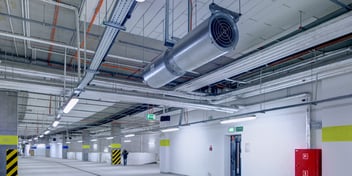

June 24, 2022
FläktGroup

Whether for simple pollution control, smoke clearance or purging, or complete smoke control, almost every car park needs ventilation. Understanding why – and the different purposes ventilation can fulfill – is key to designing and specifying the right system for each car park.
A key challenge when designing car parks – whether open-sided surface car parks, more enclosed above-ground car parks, or below-ground car parks – is to ensure adequate ventilation to maintain acceptable air quality on a day-to-day basis, as well as providing a system which will control and clear smoke in the event of a fire.
With a myriad of regulations across the globe, and a huge variety of car park designs, understanding the issues involved in ventilating car parks is key to being able to offer the best solutions for each individual case.
In this series of Ten Minute Reads, entitled ‘Car Park Basics’, we will take you through the issues involved, look in detail at the pros and cons of differing ventilation types, and illustrate the benefits of embracing enhanced design, including the use of computational fluid dynamics (CFD).
Why car parks need ventilation
There are many different types of car park, and each will have its own ventilation needs.
For example, an above ground car park, which will typically have open sides, will require less mechanical ventilation, as they are generally subject to natural ventilation (although this does make them susceptible to high winds).
Below ground car parks will require mechanical ventilation, consisting of Extract Fans, Jet Fans or Induction Fans, with levels below the first basement ideally being fitted with a powered supply.
Loading bays and service roads may need higher rates of ventilation due to their design (usually tall ceiling heights and small footprint) and the types of vehicles using them – often diesel powered heavy good vehicles.
Some below ground car parks take the form of complex tunnels, but often these are either too short or have too many joins and bends to be applicable to tunnel theory. So a combination of car park design philosophies and tunnel-specific requirements may be needed when designing the system.
Understanding fire regulations around the world
There is no single standard for designing car park ventilation systems, with significant variances around the world. This may simply be a result of cumulative local laws, or it may also take into account specific conditions in individual countries, such as the likelihood of extreme weather conditions. For example, in Scandinavian countries, very cold winter conditions may impact on system design.
It is good practice to check which specific local regulations apply, to ensure that your proposed system design will meet those local standards.
These standards can vary fundamentally. One case in point is how the basis of calculating the specific pollution control ventilation rate. Many countries’ regulations require this to be worked out based on the overall car park volume or area, the number of car parking spaces, or even just the floor area.
In the US, the ASHRAE regulation requires that the ventilation rate is calculated based on the amount of pollution generated by vehicles moving around within the car park.
During an actual fire, most regulations require an emergency smoke extraction rate to be based on a specific number of air changes per hour.
However, a design based on providing Firefighter Access (in the UK this approach is based on a Code of Practice rather than a mandatory document) is not based on a fixed air change rate, but rather on whether it will be able to provide a high enough controlling velocity to direct smoke to extract points, which will be related to the geometry of the car park and the design fire size.
Introducing the Thrust Fan System
Unlike traditional ducted systems, the Thrust Fan System removes the need for costly and space-consuming ductwork, with strategically placed arrays of compact Jet Thrust Fans precisely directing supply air (from inlet points) towards each extract point, so that a good level of ventilation is provided throughout the car park.
Supply air for such a system can be delivered in a number of ways, including via vehicle entrance or exit ramps, fresh air openings (grilles), or by using mechanical means such as air supply fans.
Not only are these systems more effective than traditional ducted systems for providing pollution control, smoke clearance or purging, and smoke control in all but the smallest car parks, but they deliver energy efficiencies, save space, and in the event of a fire, can ensure less smoke damage, better smoke containment, and allow the car park to be brought back into use more quickly.
The benefits of enhanced design
Providing an enhanced design includes computer modelling of the project, embracing computational fluid dynamics (CFD) and advanced controls.
There are significant benefits to this approach, including a higher system performance with improved smoke control, lower installation and running costs, as well as lower installation costs for other services (because they don’t need to be routed around ducts, for example).
In addition, using enhanced design optimises car park space, potentially increasing the capacity of the car park, as well as giving a cleaner appearance and producing lower external noise levels due to being able to use lower powered extract fans.
Read next: Guide to car park ventilation. Part Two.


